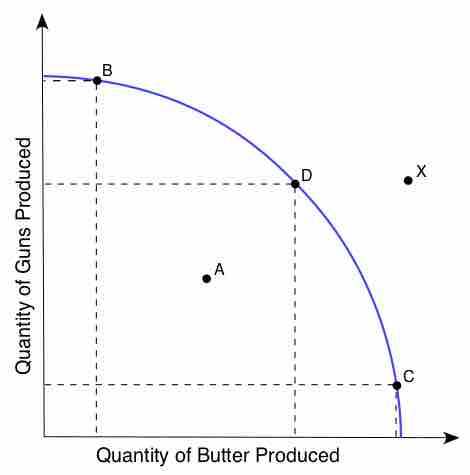In economics, the production possibility frontier (PPF) is a graph that shows the combinations of two commodities that could be produced using the same total amount of the factors of production. It shows the maximum possible production level of one commodity for any production level of another, given the existing levels of the factors of production and the state of technology.
PPFs are normally drawn as extending outward around the origin, but can also be represented as a straight line . An economy that is operating on the PPF is productively efficient, meaning that it would be impossible to produce more of one good without decreasing the production of the other good. For example, if an economy that produces only guns and butter is operating on the PPF, the production of guns would need to be sacrificed in order to produce more butter . If production is efficient, the economy can choose between combinations (i.e., points) on the PPF: B if guns are of interest, C if more butter is needed, or D if an equal mix of butter and guns is required.

Production Possibilities Frontier
If production is efficient, the economy can choose between combinations on the PPF. Point X, however, is unattaible with existing resources and technology if trade does not occur.
If the economy is operating below the curve, it is operating inefficiently, because resources could be reallocated in order to produce more of one or both goods without decreasing the quantity of either. Points outside the curve are unattainable with existing resources and technology if trade does not occur with an outside producer.
The PPF will shift outwards if more inputs (such as capital or labor) become available or if technological progress makes it possible to produce more output with the same level of inputs. An outward shift means that more of one or both outputs can be produced without sacrificing the output of either good. Conversely, the PPF will shift inward if the labor force shrinks, the supply of raw materials is depleted, or a natural disaster decreases the stock of physical capital.
Without trade, each country consumes only what it produces. In this instance, the production possibilities frontier is also the consumption possibilities frontier. Trade enables consumption outside the production possibility frontier. The world PPF is made up by combining countries' PPFs. When countries' autarkic productions are added (when there is no trade), the total quantity of each good produced and consumed is less than the world's PPF under free trade (when nations specialize according to their comparative advantage). This shows that in a free trade system, the absolute quantity of goods available for consumption is higher than the quantity available under autarky.